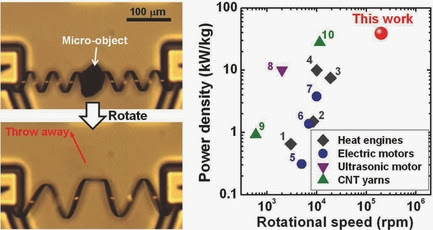Vanadium dioxide is poised to join the pantheon of superstars in the materials world. Already prized for its extraordinary ability to change size, shape and physical identity, vanadium dioxide can now add muscle power to its attributes. A team of researchers with the U.S. Department of Energy (DOE)’s Lawrence Berkeley National Laboratory (Berkeley Lab) has demonstrated a micro-sized robotic torsional muscle/motor made from vanadium dioxide that for its size is a thousand times more powerful than a human muscle, able to catapult objects 50 times heavier than itself over a distance five times its length within 60 milliseconds – faster than the blink of an eye.
Vanadium dioxide crystals also undergo a temperature-driven structural phase transition whereby when warmed they rapidly contract along one dimension while expanding along the other two. This makes vanadium dioxide an ideal candidate material for creating miniaturized, multi-functional motors and artificial muscles.
Advanced Materials – Powerful, Multifunctional Torsional Micromuscles Activated by Phase Transition
Micro bimorph coils driven by a metal-insulator phase transition in VO2 function as powerful torsional muscles. Reversible torsional motion over one million cycles without degradation is demonstrated, with a superior rotational speed up to ~200 000 rpm, amplitude of 500° per mm length, and power density up to ~ 39 kW/kg.
“Miniaturizing rotary motors is important for integrated micro-systems and has been intensively pursued over the past decades,” Wu says. “The power density of our micro-muscle in combination with its multi-functionality distinguishes it from all current macro- or micro-torsional actuators/motors.”
Wu and his colleagues fabricated their micro-muscle on a silicon substrate from a long “V-shaped” bimorph ribbon comprised of chromium and vanadium dioxide. When the V-shaped ribbon is released from the substrate it forms a helix consisting of a dual coil that is connected at either end to chromium electrode pads. Heating the dual coil actuates it, turning it into either a micro-catapult, in which an object held in the coil is hurled when the coil is actuated, or a proximity sensor, in which the remote sensing of an object (meaning without touching it) causes a “micro-explosion,” a rapid change in the micro-muscle’s resistance and shape that pushes the object away.
“Multiple micro-muscles can be assembled into a micro-robotic system that simulates an active neuromuscular system,” Wu says. “The naturally combined functions of proximity sensing and torsional motion allow the device to remotely detect a target and respond by reconfiguring itself to a different shape. This simulates living bodies where neurons sense and deliver stimuli to the muscles and the muscles provide motion.”
The vanadium dioxide micro-muscles demonstrated reversible torsional motion over one million cycles with no degradation. They also showed a rotational speed of up to approximately 200,000 rpm, amplitude of 500 to 2,000 degrees per millimeters in length, and an energy power density up to approximately 39 kilowatts/kilogram.
“These metrics are all orders of magnitudes higher than existing torsional motors based on electrostatics, magnetics, carbon nanotubes or piezoelectrics,” Wu says.
This movie shows a vanadium dioxide-based micro-muscle functioning first in micro-catapult mode, throwing out an object, and then in micro-explosion mode, whereby it senses a proximate object and reacts by pushing the object away. (Movie courtesy of Junqiao Wu group, Berkeley Lab/UC Berkeley)
The heating of the vanadium dioxide micro-muscle to actuate it can be done either globally with a tiny heating pad, or with an electrical current applied to the dual coil. Wu says heating with the electric current is the better way to go because it allows for the selective heating of individual micro-muscles and the heating and cooling process is much faster. In addition, as vanadium dioxide absorbs light and coverts it into heat, the coil can also be triggered optothermally.
“With its combination of power and multi-functionality, our micro-muscle shows great potential for applications that require a high level of functionality integration in a small space,” Wu says.
Supplemental information pdf (8 pages)
If you liked this article, please give it a quick review on ycombinator or StumbleUpon. Thanks

Brian Wang is a Futurist Thought Leader and a popular Science blogger with 1 million readers per month. His blog Nextbigfuture.com is ranked #1 Science News Blog. It covers many disruptive technology and trends including Space, Robotics, Artificial Intelligence, Medicine, Anti-aging Biotechnology, and Nanotechnology.
Known for identifying cutting edge technologies, he is currently a Co-Founder of a startup and fundraiser for high potential early-stage companies. He is the Head of Research for Allocations for deep technology investments and an Angel Investor at Space Angels.
A frequent speaker at corporations, he has been a TEDx speaker, a Singularity University speaker and guest at numerous interviews for radio and podcasts. He is open to public speaking and advising engagements.



